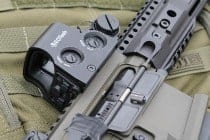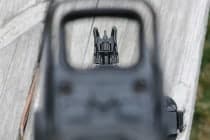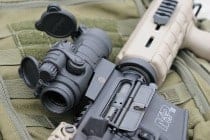The choice between an EOTech holographic weapons sight and an Aimpoint red dot sight is a win-win decision. Both sights offer amazing optical performance, near indestructibility, and a proven track record in battle.
SKIP AHEAD
EOTech vs Aimpoint Review
The downside of both of these sights are that they are fairly expensive, useless without batteries, offer no optical magnification, and are a popular target of counterfeiters.
EOTech, or Electro-Optics Technology is one tiny corner of the massive L-3 Communications Corporation based in the United States. While L-3 might sound innocuous, it is, in their own words, “A prime contractor in aerospace systems and national security solutions. L-3 is also a leading provider of a broad range of communication and electronic systems and products used on military and commercial platforms.”

|
|
Check Price on OpticsPlanet.com
Check Price on Amazon.com
|

|
|
Check Price on OpticsPlanet.com
Check Price on Amazon.com
|
Aimpoint, on the other hand, is a Swedish company that started in 1974 with the goal to improve shooting accuracy. Aimpoint's challenge was, “to create a sighting technology that would allow shooters to acquire their target quickly, and to hit moving targets in all weather and lighting conditions consistently and accurately.”
On the surface of this EOTech or Aimpoint decision, it is easy to latch onto one specific feature or specification and use it to defend a preference. EOTech usually wins on price. Aimpoint always wins on battery life. EOTech wins on reticle options. Aimpoint wins on being waterproof. EOTech wins on use with both eyes open. Aimpoint wins for staying on until the battery dies or it is shut off. EOTech wins for clearest glass. Aimpoint wins for simplest red dot. EOTech wins for smallest dot which is better for long range shooting. Aimpoint wins again on battery life (worth mentioning twice. It’s that good!). And EOTech wins for being the optic that the Seal Team Six member used on the SBR that killed Osama Bin Laden.
As the owner of both an EOTech XPS and Aimpoint, I can see strengths and weaknesses with each one. While it is almost impossible to beat the five-year battery life of the Aimpoint, it is also easy to argue that if in CQB or running-and-gunning, the EOTech provides the fastest target acquisition and least obstructed field of view which is the main purpose of the sight in the first place.
The Aimpoint uses a reflected LED (light emitting diode). The EOTech uses a laser to project a seemingly three-dimensional image on holographic film bonded to the inside of the glass window. The optical physics keep both sights parallax-free, but the extra juice needed to power a laser beam compared to the electron-sipping LED light is to blame for the extreme difference in battery life between the two sights.
Specs
The specs of the Aimpoint include:
- Weight: 7.8 ounces or 220 grams
- Submersible to 135 feet or 45 meters
- Battery life ~50,000 hours
- Battery: Lithium type 2L76 or DL1/3N
- Smallest center dot size: 2MOA

|
|
Check Price on OpticsPlanet.com
Check Price on Amazon.com
|
The specs of the EOTech include:
- Weight: 8 ounces or 227 grams
- Submersible to 10 feet or 3 meters
- Battery life ~600 hours
- Battery: Lithium type 123
- Smallest center dot size: 1MOA

|
|
Check Price on OpticsPlanet.com
Check Price on Amazon.com
|
On the surface, it appears that the Aimpoint either wins or ties in every category, with the battery type as the only debatable exception. But of course, the statistics don’t tell the whole story, and in this case we will leave plenty of room for your opinions.
Both optics are hands-down winners, and each has strengths and weaknesses depending on the particular survival situation. One sight might be quicker on target, while the other sight may be more likely to paint a target when pulled from the gun safe years later.
Look and feel
Personally, I find the EOTech much faster on target when bringing up the rifle. I can very easily see and aim the EOTech reticle while the Aimpoint dot is subject to interaction with the background colors and brightness. I can all but ignore the framing effect of the EOTech’s metal housing. It’s thinness disappears when stalking the battlefield with both eyes wide open. However, the user interface
The Aimpoint is dangerously simple. Dangerous to the bad guy, that is. With battery life in excess of five years of constant on, users often report never shutting off the sight and changing the battery on their birthday either every year or every odd year. And if you’ve ever experienced a dead electronic sight, you will certainly understand why someone would spend a small fortune on high-quality backup iron sights (even if they are made of polymer).
The EOTech is a good worker putting in an honest eight-hour day of holographic projection before shutting down on its own. On the other hand, the Aimpoint is a true soldier that will keep illuminating the bullet’s point of impact non-stop until victory or battery death. Although the probability of a sight going dark just when your life depends on it is extremely unlikely, it does roll around in the back of my head as something unacceptable. But like most massive survival situations, restarting the EOTech is probably the least of my problems.
The Aimpoint feels much bigger on the gun to me. It has a thick black ring surrounding the transparent optics that when tied with the eye-level battery compartment blocks a significant amount of
Operation
The Aimpoint’s user interface is as simple as twisting a knob clockwise to make the dot brighter, and twisting it the other way to make the dot dimmer or turn it off. The strange batteries that the CompM3 eats are found nowhere else in my tactical ecosystem, while the EOTech’s 123 batteries are also stuffed into all my Surefire flashlights and weapons lights. The only other one-off batteries in my kit live in my Leica rangefinder and my garage door opener remote control.
Ok. Now you know where I stand so tell us what you think. What side are you on in the EOTech vs. Aimpoint debate? Yes, I know all about the Trijicons on the higher end, and all the other red dot and reflex sights on the lower end, but let’s keep this debate between EOTech and Aimpoint. Otherwise the cagefight between optics might throw a high-priced, Trijicon ACOG TA31-ECOS-RMR battlesight, into the ring against a no-name Chinese-made “Holographic Tactical 1x30mm Red-Green-Blue dot sight hunting rifle scope.” And what’s the fun in that?
So where do you stand on this issue? Join the debate below. Make sure to check out more details on the products below:

|
|
Check Price on OpticsPlanet.com
Check Price on Amazon.com
|

|
|
Check Price on OpticsPlanet.com
Check Price on Amazon.com
|
Photos by: Doc Montana




